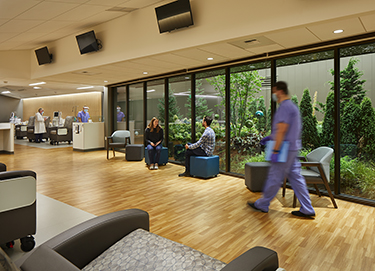|
Subscribe / Renew |
|
|
Contact Us |
|
| ► Subscribe to our Free Weekly Newsletter | |
| home | Welcome, sign in or click here to subscribe. | login |
Construction
| |
 |
July 29, 2021
Evidence-based design improves dialysis treatment experience
Mahlum Architects

Bauser
|
We have long known that our physical environment plays a key role in determining our health and wellness. More recently, we have come to the collective realization that our systems of development perpetuate deeply engrained patterns of discrimination against the most vulnerable populations within our community — a fact laid bare locally by the concentration of high-risk populations in our South Seattle neighborhoods.
Seeking to revolutionize dialysis care and address systemic inequities with its first ground-up construction, Northwest Kidney Centers and the Mahlum design team developed a new patient-centric clinical model, built around the concept of connecting patients and staff directly with nature.
The new Rainier Beach Kidney Center brings critical care to the nearly 100 patients living within one mile of the project site who, like the 500,000-some other Americans living with chronic kidney disease, had previously been spending 16 hours each week undergoing dialysis treatments in outpatient clinics which could feel chaotic, crowded and institutional. For many, this dehumanizing in-clinic experience was akin to flying from Seattle to Chicago three times weekly in the middle seat of coach. In addition, these patients were spending up to another full hour each way commuting to the closest kidney dialysis center in downtown Seattle.
Transforming an urban site previously used as a storage yard for tires, industrial scrap and derelict vehicles into a community amenity that offers biophilic healing through lush garden spaces, the placement of the patient-centric clinic, adjacent to transit and within the heart of the Rainier Beach neighborhood, removes barriers to care that have disproportionately affected the elderly and people of color, while also lessening CO2 emissions of patient transit.
Premised on the hypothesis that direct views to nature from patient care areas would increase participation with treatment regimens and improve health outcomes resulting in decreased morbidity and mortality rates, the clinic is organized to provide patients with direct views to nature while maintaining sightlines and workflows essential to clinical safety. Courtyards punctuate the clinic floor and feature biodiverse, seasonal plantings that lower stress, and bird habitats within pollinator-friendly plantings that encourage distraction therapy for pain management. The planning pairs technicians in small community groupings that support efficient clinical functions while reducing the scale and institutional feel of the care environment.
Built upon an evidence-based design approach, the project leverages research in biophilic design and environmental psychology, balancing refuge for patients with dynamic views to the layered courtyards and prospect to the community beyond. These biophilic design strategies woven throughout the clinic create an immersive and restorative environment that encourages both patient treatment compliance and staff satisfaction.
Solid walls at the patients’ backs provide a sense of refuge and direct, equitable views into native landscapes. Windows across from all patients provide views to seasonally dynamic plantings, plentiful daylighting for anchoring circadian rhythms, and opportunities for observing stochastic movement of birds and pollinators to serve as distraction therapy for patients during treatment.
Natural, warm material palettes are used throughout the facility to help lower heart rates and create a welcoming, non-institutional feel. Integration of the biophilic design patterns of prospect and mystery in the landscape design provide a balance between visual intrigue and privacy for patients to optimize their comfort and wellness.
While essential to the healing nature of the clinical environment, the internal and external garden courtyards also restore the natural habitat of the former scrapyard and link to existing greenbelts surrounding the urban site. Biodiverse, native vegetation such as ferns, fountain grasses and vine maple provide a lush habitat for local pollinators and songbirds while extending the biophilic design benefits beyond the building occupants and into the surrounding Rainier Beach community. A balanced mix between perennial and evergreen plantings ensure a dynamic, layered landscape that changes with the seasons while also serving as screening elements to provide a sense of privacy and enclosure.
The assortment of biodiverse plantings creates visual interest throughout the seasons with a variety of colors, textures and layers of deciduous plantings balanced with evergreen to create visual balance and allow occupants to connect with seasonal changes more deeply. The courtyard plantings and configuration encourage the momentary and non-rhythmic movement of birds and pollinators as a calming and welcome distraction from the clinical environment and directs patients’ attention towards the garden landscape. This form of distraction therapy has been shown to reduce patient pain and discomfort by capturing patients’ attention through non-rhythmic sensory stimuli.
In a community that is seeing rapid change and development, the biophilic design strategies utilized across the project restore and protect native ecosystems and provide amenities for the building occupants and surrounding community through prominent, public-facing garden spaces.
At the heart of all dialysis clinics is the water supply, constantly pumped through the reverse osmosis equipment to each patient’s dialysis machine and playing an essential role in removing impurities from the bloodstream when the kidneys can no longer serve this function. Applying similar rigor to the design of the systems that sustain the clinic as to the spaces the patients occupy, the design team found that this process equipment load represents over 95% of the water use for the facility and studied various options for water use reduction and reuse. The decision to move from a traditional chemical sterilization system to a heat disinfection system that cleans and recycles the clinic’s process water has delivered water usage savings of over 2 million gallons annually — a 65% reduction from baseline.
In connecting patients, staff and the broader community to the healing power of nature, the Rainier Beach Clinic is creating a new paradigm for dialysis care delivery. Operational for nearly 18 months now, the clinic is beloved by staff and patients for bringing this restorative and innovative care directly to the community which it serves and has been nationally recognized with both an AIA COTE (Committee on the Environment) Top Ten Award and an AIA Healthcare Design Award. The Rainier Beach Clinic invites us all to imagine a future with more holistically restorative health care environments.
As the leader of Mahlum’s health care studio with 16 years of architectural experience, PJ Bauser brings a knowledge of creating healthful environments and a passion for using design to serve vulnerable populations.
Other Stories:
- Aggregation will drive a new hybrid science space
- Alternative delivery benefits health care in Washington
- Next-gen health care: Building healthier communities, economies
- Micro hospitals offer the right prescription
- The shape-shifting needs of the health care industry
- Best practices in health care development and delivery
- How flexible design served OHSU during the pandemic
- The shifting need for design in health care services
- Compounding pharmacies provide community resource



